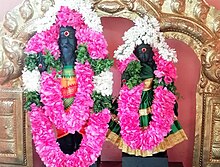
Back লোপামুদ্রা (ঋষিকা) Bengali/Bangla Lopa Mudra Spanish Lopamudra French लोपामुद्रा Hindi ലോപമുദ്ര Malayalam लोपामुद्रा Marathi ਲੋਪਾਮੁਦ੍ਰਾ Punjabi لوپامودرا Pashto/Pushto Lopamudra Portuguese லோபாமுத்திரை Tamil
This article has multiple issues. Please help improve it or discuss these issues on the talk page. (Learn how and when to remove these template messages)
|
Lopamudra, (Sanskrit: लोपामुद्रा) also known as Kaveri, Kaushitaki and Varaprada, [1] was a philosopher according to ancient Vedic Indian literature. She was the wife of the sage Agastya who is believed to have lived in the Rigveda period (1950 BC-1100 BC)[citation needed] as many hymns have been attributed as her contribution to this Veda. She was not only the consort of Agastya but a Rishiki in her own right, as she was the well known Rishiki who visualized the "Hadi Panchadasi" mantra of the Srikul Shakta tradition of Hinduism. She was one of the prominent Brahmavadinis. [2][3]
Lopamudra | |
|---|---|
 Agastya & Lopamudra | |
| Personal | |
| Religion | Hinduism |
| Spouse | Agastya |
| Children | Drdhasyu |
There are three versions of Lopamudra's legend; one is in the Rigveda Hymns; the second is in the epic Mahabharata (Vanaparva: Tirtha-yatra Parva), where there is an elaborate version with a mention that Agastya Rishi did penance at Gangadwara (Haridwar), with the help of his wife, Lopamudra (the princess of Vidarbha).[3][4] According to this legend, Lopamudra was created by sage Agastya with the most graceful parts of animals such as eyes of the deer etc.[5] The third version is Giridhara Ramayana.
- ^ Garg 1992, p. 200.
- ^ Swami & Irāmaccantiraṉ 1993, p. 242.
- ^ a b Pandharipande, Dr. Rajeshwari. "A Possible Vision of Lopamudra!". themotherdivine.com. Retrieved 8 December 2015.
- ^ "Hinduism Mahabharata, Section XCVI". Sacredtext.com. Retrieved 8 December 2015.
- ^ "Encyclopedia for Epics of Ancient India: Lopamudra". Retrieved 24 December 2006.